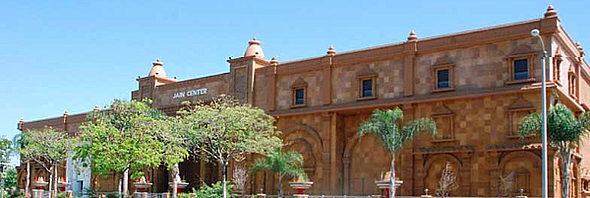

Jain Center of Southern California
Jain Center is please to announce two exciting programs, Asthaprakari Puja & 18 Abhishek of Private Idols. We invite you all to participate.
Please join us even if you were not able to register ahead of time. We will accommodate everybody.
- Saturday, Sept 19, 12:39 PM onwards - Monthly Snatrapuja and Asthaprakari Puja with detailed explanation.
- Well known Vidhikar and Scholar Shree Hiteshbhai Shah will give detailed explanation and understanding of Asthaprakari Puja. It would be a great opportunity for all to understand the meaning and purpose of all Pujas we perform.
- Nakro for Snatrapuja (not including Asthaprakari Puja)- $101
- For Asthprakari puja Boli
- Asthaprakari puja for your private idols will be performed during the same time, no nakro for that. You can participate with private idols and contribute for usage of Dravya and Kshetra of Derasar.
- Puja will be followed by Swamivatsalya dinner. Sponsorship is available.
Rituals in Jainism:
The most important rituals among Jains are worship of idols:
- Daily Puja or Worship
- Special (Parva) Puja or Worship
Daily worship of idols: Puja, Vandan, Kirtan, and Aarti.
In Puja we worship the idol with eight fold offerings. Each puja has specific significance. There are eight karmas and to destroy eight karmas we perform eight kinds of Pujas.
Aang Puja:
- Jala (Water) Puja: Water symbolizes the ocean. Every living being continuously travels through Ocean of birth, life, death, and misery. This puja reminds that one should live the life with honesty, truthfulness, love and compassion towards all living beings. This way one will be able to cross the Life Ocean and attain Moksha or liberation. The path of liberation is Samyak Darshan, Samyank Jnan and Samyak Charitra in Jain religion.
- Chandan (Sandal-wood) Puja: Chandan symbolizes Knowledge (Jnan). During this puja, one should reflect on Right Knowledge. Right knowledge means proper understanding of reality which includes Soul, Karma, and their relationship. Jainsim believes that the Path of Knowledge is the main path to attain liberation. Bhakti or Devotion helps in the early stages of one’s effort for liberation.
- Pushpa (Flower) Puja: Flower symbolizes conduct. Our conduct should be like a flower, which provides fragrance and beauty to all living beings without discrimination. We should live our life like flowers with full of love and compassion towards all living being.
Agra Puja:
- Dhup (Incense) Puja: Dhup symbolizes ascetic life. While burning itself, Dhup provides fragrance to others. Similarly true monks and nuns spend their entire life selflessly for the benefit of all living beings. This puja reminds that one should thrive for an ascetic life which ultimately leads to liberation.
- Deepak (Candle) Puja: The flame of Deepak represents a Pure Consciousness or a Soul without any bondage or a Liberated Soul. In Jainsim, such a soul is called Siddha or God. The ultimate goal of every living being is to become liberated from karma. By doing this puja, one should thrive to follow Five great Vows: Non-violence, Truthfulness, Non-stealing, Chastity, and Non- possession. Ultimately these proper conducts couple with right faith and knowledge will lead to liberation.
- Akshat (Rice) Puja: The household rice is the kind of grain seeds, which are non- fertile. One cannot grow rice plants by seeding the household rice. Symbolically it means that rice is the last birth. By doing this puja one should thrive to put all the efforts in the life in such a way that this life becomes one’s last life and after the end of this life one will be liberated and will not be reborn again.
- Naivedya (Sweet) Puja: Naivedya symbolizes a tasty food. By doing this puja, one should thrive to reduce or eliminate the attachment to tasty food. Healthy food is essential for survival, however one should not live to eat a tasty food. Ultimate aim in one’s life is to attain a life where no food is essential for our existence and that is the life of liberated soul, who lives in Moksha forever in ultimate bliss.
- Fal (Fruit) Puja: Fruit symbolizes Moksha or Liberation. If we live our lives without any attachments to worldly affair, continue to perform our duty without any expectation and reward, be witnessed to all the incidents that occurred surrounding to and within us, truly follow ascetic life, and have a love and compassion to all living beings, we will attain fruit of Moksha or liberation. This is the last puja symbolizing the ultimate achievement of our life. In the end we adorn the idol- Call Aangi- usually very attractive, creates good bhav during Darshan.
Bhav Puja:
After the idol worship is done, we do bhav puja, recite studies, do chaitya vandan etc. All the ceremonies help us in two ways. First, we feel happy, our heart experiences an internal joy. Secondly, it helps in destroying kashayas, plant seeds of good qualities in us and destroy many karmas. Understanding the meaning of all sutras certainly helps us in increasing bhava, joy and instead of a ritual, it becomes a daily necessity.
- Sunday,Sept 20 | 18 Abhishek of Private Idols -- 12:30 pm to 5:30 pm,
- Followed by Swamivatsalya dinner from 5:30 to 6:30 pm.
- Nakro for 18 Abhisheks $101
- To participate in 18 Abhisheks, contact:
Ketan Parekh at 714 299 6789, or
Kinal Modi at 714 290 9981,
for the office of Public Relations
Jain Center of Southern California